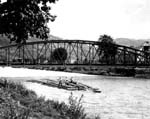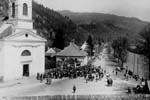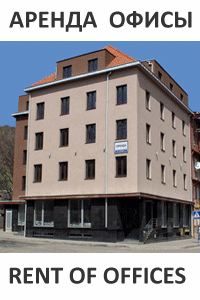|
|
|
History
History dates the foundation of Rakhiv in 1447, but here was found treasure, the copper-bronze objects of the late bronze period (the end of the II-nd beginning of the I-st millennium B.C.) that testifies about human activities on this territory more than three thousand years ago. There exist several legends and versions about the city name origin. They are related to motion of opryshky, which allegedly counted in this locality goods which they took away from rich men and divided it between poor people. Other version: merchants on a way from Transylvania and Hungary to Galicia were stopped here and counted their incomes. Possibly, the name of the city originates from the proper name Rakh or Rakho.
 The first settlers of the city were peasants from Galicia and Transcarpathia, which escaped into the mountains from the rich people yoke. The population was mainly engaged in the cattle breeding, in particular (sheep breeding) and also in fishing, hunting, beekeeping and partly agriculture. People have been living in kolyby (small wooden house like shanty), and after some time built homes called grazhdi (bigger houses). From IX to XI century the territory of the future city entered in the complement of the Kyivan Rus', in XII - XIII century in the complement of Galicia-Volyn principality, and from the end of the XIII century Hungary captured the mountain districts of Transcarpathia including settlement on the territory of the Rakhiv. Gradually, Hungarian feudal lords began to arrive, it cause to the strengthening of the national oppressing. In the XVI century Rakhiv gets into the fortress dependence of Velykobychkiv public dominion, and from the XVII century added to the Khust public dominion. The habitants of the Rakhiv paid taxes: supplied wood and meat.
The first settlers of the city were peasants from Galicia and Transcarpathia, which escaped into the mountains from the rich people yoke. The population was mainly engaged in the cattle breeding, in particular (sheep breeding) and also in fishing, hunting, beekeeping and partly agriculture. People have been living in kolyby (small wooden house like shanty), and after some time built homes called grazhdi (bigger houses). From IX to XI century the territory of the future city entered in the complement of the Kyivan Rus', in XII - XIII century in the complement of Galicia-Volyn principality, and from the end of the XIII century Hungary captured the mountain districts of Transcarpathia including settlement on the territory of the Rakhiv. Gradually, Hungarian feudal lords began to arrive, it cause to the strengthening of the national oppressing. In the XVI century Rakhiv gets into the fortress dependence of Velykobychkiv public dominion, and from the XVII century added to the Khust public dominion. The habitants of the Rakhiv paid taxes: supplied wood and meat.After the defeat of Hungary-Czech army in a battle with Turks under Mogach in 1526 Hungary disintegrated. Greater part of Transcarpathia, including Maramorozh komitat in which Rakhiv was included, stepped back to Semygrad principality which became the vassal of the Turkish empire in course of time, and the remains of territory appeared under the power of Austria. Habsburgs laid hands on all territory of the edge at the end of the XVII century. The local population was beggared not only from taxes and duties but also from intestine wars of Transylvanian princes and Austrian gentlefolks, and also from raids of Turkish detachments. It resulted in the origin of opryshky motion and peasant rebelling. The habitants of Rakhiv district actively participated in detachments of folk avengers, including Oleksa Dovbush. From the folk retelling which H.Khotkevych wrote down at the beginning of the XX century, we know that one of the most devoted sworn brothers of the brave leader was Ivan Rakhivskij. Rakhiv grows in course of time. If in 1600 year, 14 peasant courts were counted here, then in 1720 there were 54. From the middle of the XVII century the right bank of river Tisza is more intensively populated, here begins the booty of salt which is alloyed downward the river by rafts-daraby (a float of wood) to the Velikij Bichkov (village), and then - to Khust and Hungary.  A folk trades which up to now vernacular for Rakhiv was developed with growth of population. In the first half of the XIX century, from 2854 person of population 207 were busy with handicraft, poor peasants for food were hired as shepherds to prosperous hazdam (noble owners), which after Maria-Teresa urban (land) reform got the parcels of land. A historical certificate certifies that the first wooden bridge in Rakhiv was built through Tisza in 1782. At that time settlement already becomes the place of economic, political and cultural life of Tisza's riverhead. A stock-raising, mastering of alpine pastures that were rich in motley grass, acquires development, letting to increase the population of cows, sheep and goats. At the market they sold different wares of artisans, cattle and salt. The comfortable trade-route that since olden times passed through the village rendered assistance to its development and Rakhiv becomes a district centre.
A folk trades which up to now vernacular for Rakhiv was developed with growth of population. In the first half of the XIX century, from 2854 person of population 207 were busy with handicraft, poor peasants for food were hired as shepherds to prosperous hazdam (noble owners), which after Maria-Teresa urban (land) reform got the parcels of land. A historical certificate certifies that the first wooden bridge in Rakhiv was built through Tisza in 1782. At that time settlement already becomes the place of economic, political and cultural life of Tisza's riverhead. A stock-raising, mastering of alpine pastures that were rich in motley grass, acquires development, letting to increase the population of cows, sheep and goats. At the market they sold different wares of artisans, cattle and salt. The comfortable trade-route that since olden times passed through the village rendered assistance to its development and Rakhiv becomes a district centre.Bourgeois-democratic revolution in Austria and Hungary (1848-1849) came to the Rakhiv, as a result in 1853 on the territory of Transcarpathia serfdom was liquidated. With formation in 1867 of Austro-Hungarian Empire some economic reforms began, though, to the habitants of Rakhiv region they gave nothing. Peasants who had not lend, had to lease it, work as a farm labourer, provide the forest for keeping their families. In 1908, 110 habitants were bringing over in providing the forest. By a considerable shove to socio-economic development at the end of the XIX century for Rakhiv was building of railway road through the settlement. The road was built in 1894 by Italians. In a result the settlement became a circuit centre.  The First World War brought to citizens of Rakhiv a new suffering; in fact the village became the arena of fights between belligerents and couple times passed from hands to hands. Military actions, robberies, a price advance had been dooming people on starvation.
The First World War brought to citizens of Rakhiv a new suffering; in fact the village became the arena of fights between belligerents and couple times passed from hands to hands. Military actions, robberies, a price advance had been dooming people on starvation. In November, 1918 after Austro-Hungarian disintegration, Rakhiv citizens resolutely rose on a fight for liberation and reunions of the edge with the Ukrainian people took active part in formation and support of Guzul Republic (1919) a centre of which was in the village Yasinya, the leader was S. Klochuryak. In April, 1919, with the proletarian revolution victory in Hungary, in Rakhiv the Soviet of workers, soldiers and peasants was led by P. Popenko, but the settlement was occupied by the Romanian troops. The robberies and pursuits began. From 1919 to 1939 Transcarpathia is included to Czechoslovakia. Rakhiv remains a centre of Rakhiv circuit. Comparatively with an antecedent, a political order becomes more democratic. Here was organized local school with Ukrainian language teaching, and in 1938 - Ukrainian gymnasium. The roads are laid, Rakhiv restores as a shopping centre; tourism acquires development. After the proclamation of Podkarpatska Rus' as autonomy and than an independence of Carpathians Ukraine, on 18th of March 1939 Rakhiv was occupied by Hungarian troops. Terror established. At the beginning the Second World War many people were abandoned into the concentration camps, prisons. Others were escaped from homes in search of good fate in other countries. On October, 16, 1944 Rakhiv was freed by soviet troops of the 4th Ukrainian front and more than 500 habitants voluntarily went to contest with fascists. From June, 29, 1945 all Transcarpathia, including the village, entered into the complement of the Soviet Ukraine, as circuit, and then district centre. From January, 1946 Rakhiv becomes a settlement, and from 1957 - a city. Here are placed administrative houses of Carpathian Biosphere Reserve, territory of which is attributed to most valuable ecosystems of Earth and included into the international network of biosphere reserves of UNESCO. For years of soviet power, Rakhiv became a large industrial and cultural centre. In particular, a cardboard factory was built; in 1960 the timber industry enterprise and forestry of Rakhiv that were organized in the first years of liberation were united in Rakhiv integrated forestry mill, the workers of which were engaged in lumbering areas and landing the forest. V. Shorban the Hero of Socialistic labour becomes a pride of the edge. In general over 10 industrial enterprises worked in town, in work were attracted more than 3000 workers, including high-skilled employee.  Large scope was purchased by house building; new streets were creating as a result, many market and public food consumption enterprises appeared. A district hospital, children mountain-sky sporting school, libraries for adults and children, house of culture, general schools, preschool and other start to operate.
Large scope was purchased by house building; new streets were creating as a result, many market and public food consumption enterprises appeared. A district hospital, children mountain-sky sporting school, libraries for adults and children, house of culture, general schools, preschool and other start to operate.Amateur art in town attained an almost professional level. The large popularity achieved folk band of song and dance "Carpaty" and Integrated forestry mill orchestra of guzul folk instruments. Annually in June was organizing holiday called National complement has an impact on features of religious and cultural life of the city. The row of religious communities are registered here, Orthodox, Roman Catholic, Byzantine-rite Catholic temples, To services of Rakhiv citizens and guests are district and child's libraries; house of culture, a mountains ecology museum of preserve, child's musical school. Rakhiv is known cultural centre Guzul'shina - this unique land from time immemorial was glorified by original talents. The Folk orchestra of guzul instruments, vocal-instrumental band In a centre of a city monuments to Soviet Union Hero O. Borkanyuk, lost soldiers-liberators (1978) and also to T.H.Shevchenko( 1993) are set. Due to a geographical location, unique nature and original guzul culture, Rakhov got fame as "Guzul-Paris". In 1997 symbols of the city (flag, coat of arms, seal), which was working out by Institute of Ukrainian History of National Academy of Ukraine, was ratified, and the keeping books of the honoured citizens of the city are begun. |








